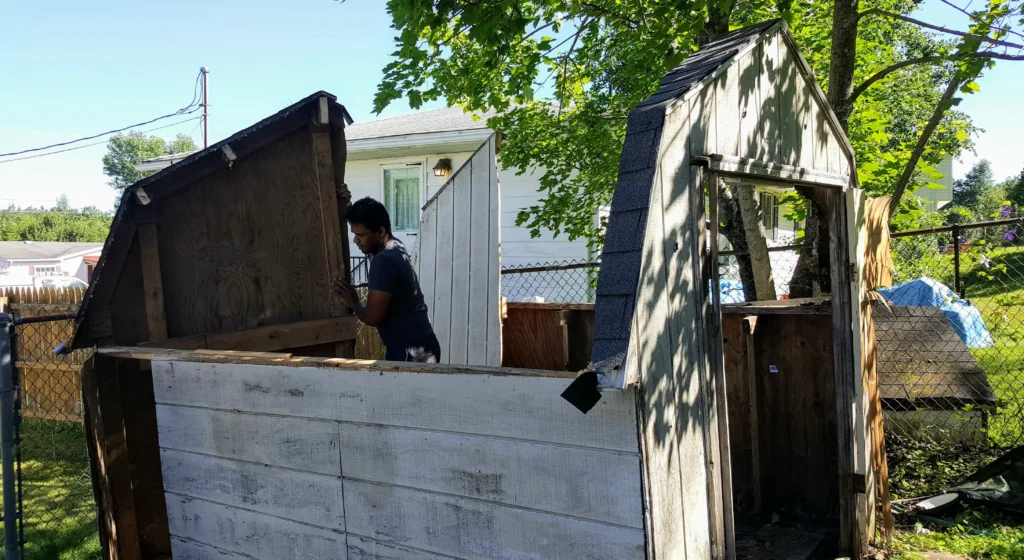
Removing a shed from your property involves choosing the right method that fits your budget, timeline, and safety considerations. Each approach offers distinct advantages and challenges, catering to different needs and preferences. In this comprehensive guide, we’ll explore in-depth the options available for shed removal, helping you decide on the best approach for your project.
1. DIY Shed Removal
Pros:
Cost-Effective Flexibility: DIY shed removal allows you to save on labor costs and control the project timeline according to your schedule.
Skill Development: It presents an opportunity to develop hands-on skills in demolition and construction, which can be rewarding for DIY enthusiasts.
Personal Satisfaction: Completing the removal yourself can provide a sense of accomplishment and ownership over the project.
Cons:
Safety Risks: Demolition work can be hazardous without proper tools, safety gear, and knowledge of structural integrity.
Time-Consuming: DIY projects often take longer to complete, especially if unexpected challenges arise during demolition or disposal.
Disposal Challenges: Handling and disposing of shed materials responsibly can be complex without access to recycling facilities or waste management services.
2. Professional Shed Removal Services
Pros:
Expertise and Efficiency: Professional shed removal services bring expertise and specialized equipment, ensuring efficient and safe dismantling and disposal.
Safety Assurance: Trained professionals follow safety protocols and regulations, minimizing risks of accidents and ensuring compliance with local laws.
Convenience: All aspects of shed removal, including site preparation, dismantling, and waste disposal, are handled by the service provider, reducing stress and effort on your part.
Cons:
Cost Considerations: Hiring professionals can be more expensive upfront compared to DIY methods, depending on the size and complexity of the shed.
Scheduling Challenges: Availability of professional services may vary based on seasonal demand and scheduling conflicts, potentially delaying your project timeline.
3. Shed Removal Companies vs. General Contractors
Shed Removal Companies:
Specialized Expertise: Dedicated shed removal companies offer focused expertise in handling sheds of all sizes and materials, ensuring thorough and efficient service.
Environmental Responsibility: They prioritize eco-friendly disposal methods, recycling materials whenever possible and adhering to local environmental regulations.
Customer Satisfaction: Tailored services and attention to detail specific to shed removal, providing a seamless experience from start to finish.
General Contractors:
Versatility: General contractors offer a range of construction and renovation services, including shed removal, which can be convenient if you require additional work beyond removal.
Varied Expertise: Shed removal may not be their primary focus, potentially affecting efficiency and cost-effectiveness compared to specialized shed removal companies.
4. Renting Equipment vs. Using Hand Tools
Renting Equipment:
Efficiency Boost: Powered tools such as excavators or mini-diggers accelerate the demolition process, particularly beneficial for larger or more complex sheds.
Cost Considerations: While equipment rental incurs additional costs, it can save time and physical effort compared to manual methods.
Skill Requirement: Operating heavy machinery requires some level of skill and familiarity, ensuring safe and effective use during demolition.
Using Hand Tools:
Affordability: Basic tools like hammers, pry bars, and saws are cost-effective and readily available for DIY shed removal projects.
Labor-Intensive: Demolition using hand tools is labor-intensive and may require more time and physical exertion to complete, especially for larger sheds.
Control and Precision: Provides greater control over the demolition process, allowing for careful dismantling of shed components.
5. Community or Volunteer Assistance
Pros:
Cost-Effective Support: Community or volunteer assistance can offer free or low-cost labor, reducing overall project expenses.
Community Engagement: Involving volunteers fosters community spirit and collaboration, enhancing local relationships and goodwill.
Shared Experience: Volunteers may bring diverse skills and perspectives to the project, contributing to a comprehensive removal effort.
Cons:
Skill and Coordination Challenges: The quality of work and safety standards may vary depending on volunteer experience and availability.
Coordination Efforts: Organizing volunteers and ensuring a cohesive work plan can be time-consuming and require effective leadership.
Choosing the Right Method for Your Shed Removal
Factors to Consider:
Project Scope: Evaluate the size, condition, and location of your shed to determine the most suitable removal method.
Budget Constraints: Set a realistic budget that considers costs for labor, equipment rental, waste disposal, and any unforeseen expenses.
Safety Precautions: Prioritize safety by using appropriate tools, protective gear, and following recommended demolition practices.
Environmental Impact: Opt for methods that align with sustainable practices, such as recycling materials and minimizing landfill waste.
Conclusion
Selecting the best shed removal method involves careful consideration of your project goals, resources, and safety priorities. Whether you choose DIY demolition, professional services, or community support, each approach offers unique benefits and challenges. By weighing these factors and planning accordingly, you can ensure a successful shed removal project that enhances your property and meets your expectations.
